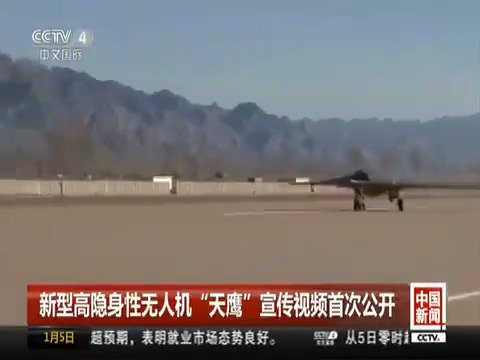A video showing China’s flying-saucer-like stealth drone, the Sky Hawk, was aired for the first time on China Central Television (CCTV) on January 5th.
Reportedly, the Sky Hawk conducted takeoff and landing tests at an undisclosed location and at an undisclosed time. This marks the first time the UAV was publicly shown in flight.
The video is mostly computer-generated, but has approximately 10 seconds of “real-life” footage. The platform contains seven different cameras, including an infrared camera and multispectral sensors. It has a wingspan of 18 meters and can reach a maximum cruising altitude of 7.5 km, and can deliver a payload of 815 pounds.
The drone reportedly first flew in February, but no video was available before January 5th’s broadcast. It was on display at Airshow China 2018 in Zhuhai, South China’s Guangdong Province in November 2018 but was never flown there.
According to Song Zhongping, a military expert and TV commentator, cited by state-owned Global Times, “the step-by-step revelations mean the drone is being developed and manufactured on schedule, and that China considers the drone feasible.”Featuring a “flying wing” aerodynamic design similar to the US B-2 stealth bomber, the Sky Hawk is a high-altitude, long-range and high-speed unmanned aerial vehicle capable of conducting reconnaissance and patrol missions in hostile environments, CCTV reported.
Song Zhongping further said that the “flying wing” design is much more difficult to control than controlling an aircraft with a conventional design. “A turbofan engine on a flying wing aircraft allows it to fly much faster and farther compared with traditional turboprop or piston engine aircraft”, he said.
“Another Chinese stealth drone with a “flying wing” design, the CH-7, developed by China Aerospace Science and Technology Corporation, was also on display at the air show. Its 22-meter wingspan makes it significantly larger than the Sky Hawk, providing another choice for domestic and international users,” the Global Times reminded.The Global Times further cited an anonymous military expert who said that the Sky Hawk was expected to operate on China’s future aircraft carriers. “Electromagnetic catapults can launch a wide variety of aircraft, and since the Sky Hawk is smaller than the CH-7, it will be easier to use on an aircraft carrier,” the anonymous source said.
China’s new strategic bomber, the H-20 is also expected to use a “flying wing” aerodynamic design to gain stealth capability and other benefits.







Comments
Post a Comment